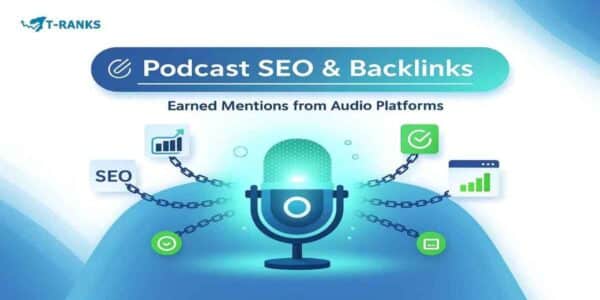Podcast SEO is becoming one of the fastest ways to grow online visibility. In 2025, there are about 4.5 million active podcasts and over 580 million listeners worldwide . As people spend more time listening instead of reading, podcasts have turned into powerful tools for brand growth and search visibility.
For businesses, this trend opens a major SEO opportunity. When you host a podcast or appear as a guest, your website link often appears in show notes, episode pages, or directories. These are called podcast backlinks authentic, natural mentions that help you build authority, drive referral traffic, and improve rankings.
Podcast SEO works because it connects real conversations with search intent. Every optimized episode, transcript, and description adds to your brand credibility and helps search engines understand your expertise.
In this guide, you’ll learn simple ways to turn your podcast into a long-term SEO asset. You’ll discover how to structure metadata, apply schema for AI visibility, and use each episode to build lasting authority online.
What Is Podcast SEO
Podcast SEO means optimizing your podcast so people and search engines can easily find it. It focuses on your audio files, titles, descriptions, transcripts, and platform distribution so your episodes appear in Google Search, YouTube results, Spotify, and AI Overviews.
In Short: Podcast SEO connects your audio content with your website’s SEO goals — helping your podcast attract listeners and build authority for your brand online.
Why Podcast SEO Matters for Businesses
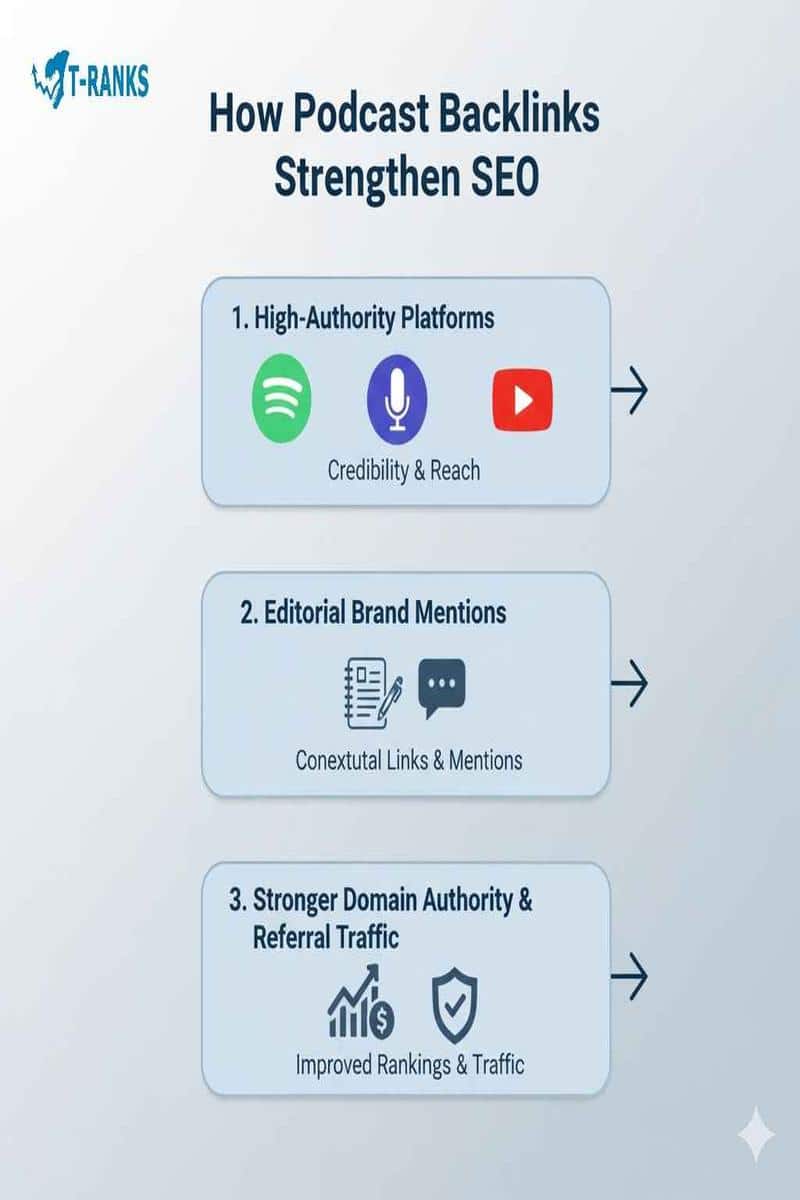
Podcasts are no longer just for entertainment. They now act as powerful SEO tools. When your podcast is published or featured on trusted platforms like Spotify, Apple Podcasts, or YouTube, the platform usually includes a link to your website or brand page.
These are called Podcast Backlinks — and they matter because:
- They come from high-authority domains (Spotify, YouTube, Apple).
- They act as editorial mentions, proving your brand is trustworthy.
- They help your business website rank higher by strengthening your backlink profile.
- And most importantly, today’s audiences prefer listening and watching over reading.With the rise of short videos, reels, and podcasts, it’s now easier and faster to promote your brand through audio and video storytelling than long written blogs.
Every guest appearance, episode, or show note that includes your brand name or website becomes a small but strong SEO signal.
How Podcast Backlinks Work
Search engines read podcast listings and show notes just like they read web pages. If your brand name, website link, and target keywords (for example, T-RANKS, backlink strategy, SEO link building) appear in your podcast metadata, they create contextual backlinks.
These links tell Google and AI systems:
“This brand has expertise in this topic.”
Over time, these signals increase your domain authority and trust score, which helps your main website appear higher in search results.
Example: Real-World Scenario
Imagine T-RANKS appearing on a well-known marketing podcast hosted on a platform like Spotify or Podbean. If that episode includes a link such as “expert link-building agency T-RANKS” in its description or show notes, it becomes a high-quality backlink from a trusted source.
The same happens when you host your own podcast and publish episodes with show notes linking to your services or SEO resources, every mention adds to your website’s authority.
Key Takeaway
Podcast SEO isn’t only about getting more listeners. It’s about turning each episode, transcript, or guest feature into a link-earning opportunity that helps your business website grow stronger in search. The more structured and consistent your optimization, the more visibility and backlinks you gain over time.
Podcast Link Building: The Natural Backlink Machine
Podcast link building works because it earns natural and trusted backlinks. Every episode or guest appearance creates a digital mention that connects your brand, topic, and authority in search systems. Unlike traditional outreach, these links grow through genuine expertise and real conversations.
Podcast backlinks send strong trust signals in three ways:
- Co-citation: your brand and topic appear together across different websites.
- Entity association: search engines recognize your brand, hosts, and guests as connected experts.
- Topical alignment: your discussions match your target keywords naturally.
Together, these factors make podcast backlinks one of the most organic and powerful ways to build authority online.
(Internal link: How to Build High-Quality Dofollow Backlinks for Better Rankings)
How Podcast Backlinks Build Authority
When your podcast appears on Spotify, Apple Podcasts, or Listen Notes, it often includes a link to your website in the show notes or guest bio. These are not paid or forced backlinks. They are organic mentions from high-authority platforms that naturally support your SEO.
Each link brings three main benefits:
- It adds contextual relevance to your topic.
- It sends referral traffic from real listeners.
- It increases entity trust through consistent brand visibility.
These combined signals help your website gain steady visibility and lasting credibility in search.
Main Sources of Podcast Backlinks
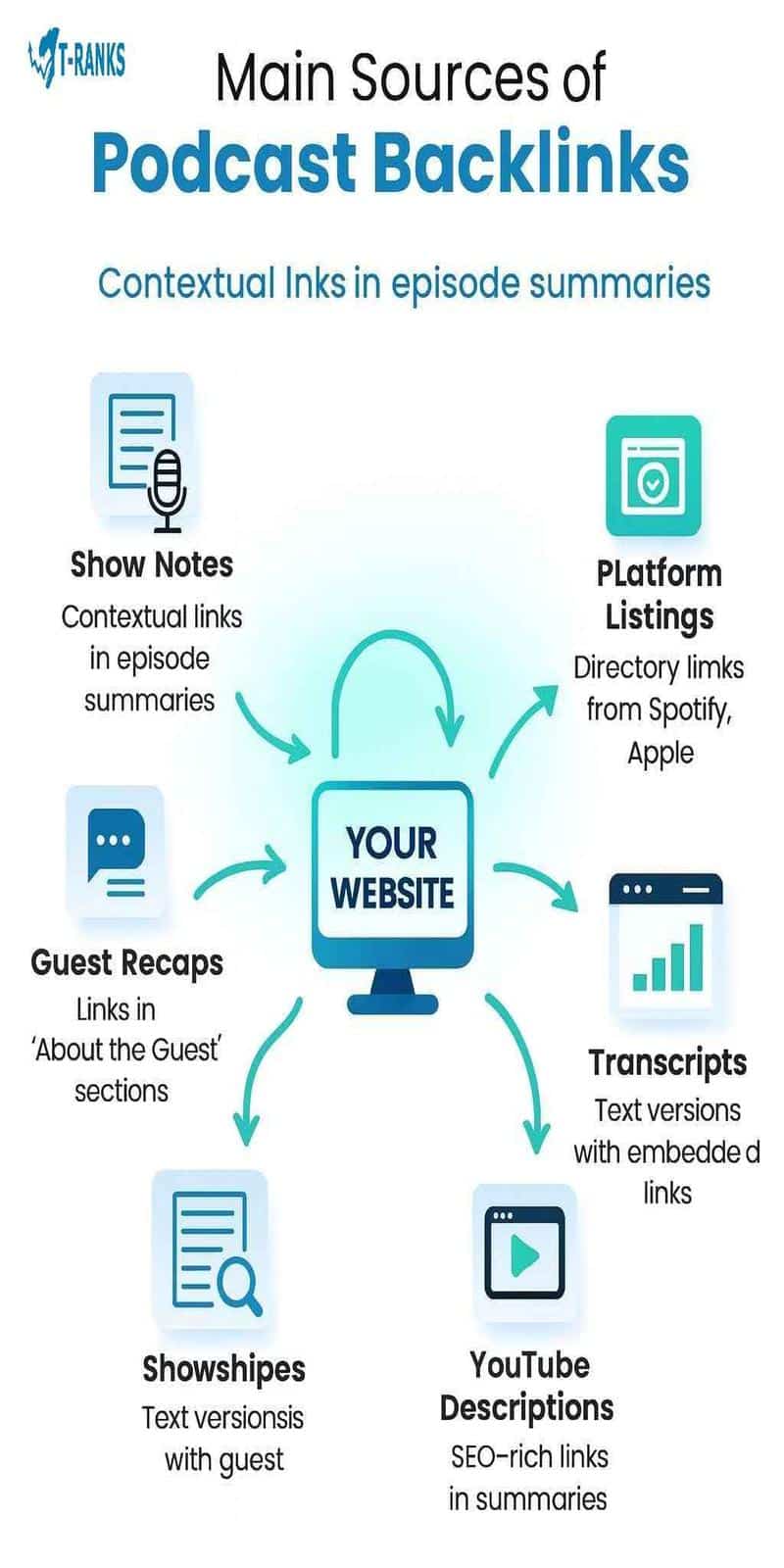
| Source | Description | SEO Value |
| Show Notes | Contextual backlinks added by podcast hosts. | High |
| Guest Bios | Links in the “About the Guest” sections. | Medium |
| Press Recaps | Mentions in media articles or newsletters. | High |
| Platform Listings | Directory links from Spotify, Apple, or Podbean. | Medium |
| Repurposed Transcripts | Text versions of episodes with embedded links. | High |
| YouTube Descriptions | Links in video summaries or pinned comments. | High |
Even if some links are nofollow, they still improve your overall authority and help AI systems recognize your brand.
Guesting vs Hosting: Which Builds Links Faster

Guesting helps you earn backlinks quickly because other hosts link to your website in their episodes. Hosting builds long-term value because you control the structure, schema, and keyword targeting.
Guesting grows visibility faster, while hosting strengthens your brand over time.
A feature on a high-traffic, relevant podcast can score around 0.86 PPR, showing excellent value for both SEO and branding.
Request a Free Podcast Backlink Audit from T-RANKS to review your earned mentions, authority signals, and link-building potential.
Step-by-Step: Building Backlinks Through Podcasts
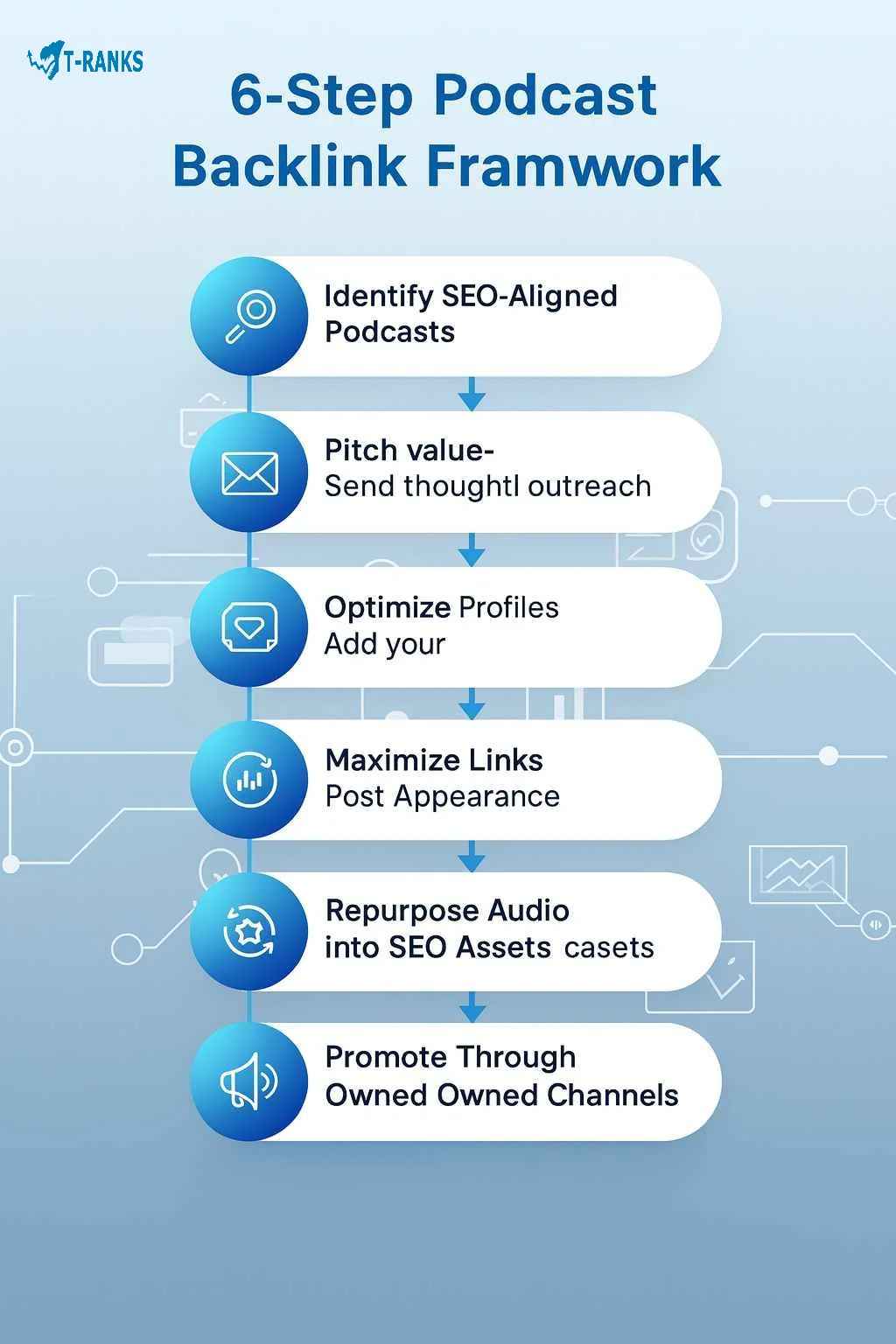
Podcast link building is a repeatable SEO process, not a one-time guest spot. Done right, it earns contextual editorial backlinks while positioning your brand as an authority. Each appearance can raise domain authority, grow brand mentions, and increase visibility across Google,ChatGpt, Perplexity and AI Overviews.
At T-RANKS, we use a six-step framework that turns every podcast episode into long-term link equity and measurable SEO results.
Step 1 – Identify SEO-Aligned Podcasts
Start by finding podcasts that match your industry, audience intent, and topical focus. Google values backlinks from contextually related shows more than random mentions.
How to research relevant podcasts
- Use directories such as Podchaser, Listen Notes, or Apple Podcasts to discover shows in your niche.
- Review competitors’ guest spots in Ahrefs, Moz, or Semrush by filtering URLs containing “/podcast/” or “/episode”.
- Score each opportunity by Relevance × Authority × Conversion Potential.
Example If you’re a SaaS marketer, appearing on a podcast like B2B Growth—focused on marketing automation—brings much stronger SEO value than a generic entrepreneurship show because it attracts the right audience and topical trust.
(Internal link suggestion → Link Risk Management: Spam Policies, Manual Actions & Recovery)
Step 2 – Pitch Value-Driven Appearances
Your outreach shapes your success. Podcast hosts receive dozens of messages weekly, so send personalized, value-based pitches.
Use the Problem → Proof → Pitch model
- Problem: mention a pain point relevant to the host’s listeners.
- Proof: share a quick stat, data point, or case study.
- Pitch: suggest two or three focused discussion ideas.
Example email
“Hi [Host], I really enjoyed your recent episode on [Topic]. Many marketers still struggle with [Problem]. At T-RANKS, we found podcasts can generate up to 35 percent more natural backlinks than blog posts. I’d love to share actionable ideas on how to turn podcast appearances into linkable assets. Would you be open to a 20-minute guest session next month?”
Track replies with Lemlist or Postaga, and personalize each message with details from the host’s latest episode.
Step 3 – Optimize Your Podcast Profiles
Before recording, align your brand identity across all platforms. AI systems confirm authority through entity consistency, not credentials alone.
Checklist
- Keep your LinkedIn, Crunchbase, and website bios identical.
- Add Person or Organization schema with “sameAs” links to verified profiles.
- If you host a podcast, connect your Organization schema to your RSS feed.
- Use the same logo, tagline, and visual style everywhere.
Example
Suppose your brand is T-RANKS. You’d ensure “T-RANKS SEO Agency” appears exactly the same on your website, LinkedIn, podcast bios, and schema markup. Include your social URLs (LinkedIn, X, YouTube) in the “sameAs” property of your Organization schema. This unified identity tells Google and Gemini that all these profiles belong to one verified entity, increasing AI Overview visibility and entity trust across search.
Step 4 – Post-Appearance Link Maximization
Your backlink opportunity begins after your episode is live. Don’t assume your link is included—verify and optimize it.
Checklist
- Review show notes, blog recaps, and YouTube descriptions for your link.
- If absent, request a branded anchor such as “Research by T-RANKS” or “Full SEO Study.”
- Offer downloadable assets (PDFs, infographics) the host can embed; each counts as another contextual backlink.
- Thank the host publicly and share the episode to multiply reach.
Example
At T-RANKS, a single guest appearance that earns backlinks from the show notes, YouTube description, and a LinkedIn tag can generate three to five quality links within a week — all from one episode.
Step 5 – Repurpose Audio into SEO Assets

Each episode is content gold. Repurposing extends reach and link potential.
Ideas to repurpose
- Convert transcripts into SEO-optimized blog posts or case studies.
- Create infographics, social carousels, and short videos summarizing key points.
- Post 15- to 60-second audiograms on YouTube Shorts, Instagram, or TikTok linking back to your main episode.
- Add PodcastEpisode and Article schema so search engines connect these assets.
Example An episode titled “How AI Changes Backlink Building” can become:
- A blog post optimized for AI SEO backlinks
- A short YouTube clip with a memorable quote
- A LinkedIn article linking to your site
Together, these assets form a semantic network that reinforces your topical authority and strengthens link diversity.
Step 6 – Promote Through Owned and Earned Channels
Promotion turns one appearance into ongoing visibility. Each share or mention creates co-citation signals—the same semantic patterns AI uses to identify trustworthy brands.
How to promote
- Publish the episode on your blog, newsletter, and social media with visuals and short captions.
- Encourage hosts and guests to share on their own feeds.
- Join LinkedIn threads, Reddit discussions, or SEO communities where your topic adds genuine value.
Example
A 20-second highlight clip captioned “Podcast SEO simplified: how one episode earned five backlinks 🎙️ #PodcastSEO” can gain hundreds of reshares across LinkedIn, X, and Instagram. Many of these organic mentions turn into secondary backlinks that steadily increase authority in Google and AI search results.
Optimizing Podcast Metadata for SEO
Podcast metadata is the information that tells search engines what your show is about. It includes your titles, episode descriptions, transcripts, and embedded audio details. When this data follows a clean and consistent structure, search engines can easily understand your content, rank it higher, and cite it in AI summaries.
In this section, we’ll explore three core parts of metadata optimization that directly affect visibility and link authority:
1. Titles and Episode Descriptions
2. Transcripts and Time-Stamped Notes
3. Embedding Podcasts in Blog Articles
Let’s go through each one and see how to apply them effectively.
1. Titles and Episode Descriptions
Titles and descriptions are the most visible parts of your podcast. They appear in search results, Spotify listings, YouTube videos, and AI Overview snippets — so they must clearly explain what your episode offers.
Use this title structure: [Keyword Phrase] + [Topic Angle] + [Audience Benefit]
Example: “AI SEO Podcast: How to Build Topic Clusters That Rank Faster in 2025”
Best practices
- Keep titles under 65 characters so they display properly across platforms.
- Add main and secondary keywords naturally, such as AI SEO, podcast backlinks, or link building.
- Mention guest names, timestamps, or a call-to-action in the description.
- Maintain a consistent format on every platform to help AI tools match your metadata.
- Avoid keyword stuffing — write in clear, conversational language.
A well-structured title and summary not only improve click-through rates but also increase your chances of appearing in AI Overviews, Featured Snippets, and Spotify searches.
2. Transcripts and Time-Stamped Notes
Transcripts convert your audio content into readable, indexable text. They’re one of the easiest ways to help search engines and AI systems understand what’s discussed in each episode.
How to optimize transcripts
- Use Descript, Riverside, or Otter.ai to generate automatic transcripts.
- Manually review and clean them to remove filler words and errors.
- Add internal links to your related guides or SEO articles for deeper engagement.
- Insert timestamps to mark topic shifts and help both users and crawlers scan faster.
Example Transcript Snippet:
00:00 – Introduction: Why Podcast Metadata Matters for SEO
02:15 – Optimizing Titles & Descriptions for AI Overviews
05:30 – How Time-Stamps Help Google Understand Context
08:45 – Linking Transcripts to Blog Articles and Resources
Pro Tip: Always publish your transcript directly under the player or as a separate page. It adds more indexable text, gives your site keyword depth, and helps your podcast rank for long-tail questions and voice searches.
3. Embedding Podcasts in Blog Articles
Embedding your podcast in relevant blog posts helps search engines connect your audio and written content. This combination builds topic authority and keeps visitors engaged longer.
How to optimize embedded podcasts
- Place your embedded player at the top or middle of the post for higher engagement.
- Surround it with short, keyword-focused paragraphs explaining the topic.
- Add PodcastEpisode or AudioObject schema to show Google how the audio connects to the page.
- Link internally to other episodes, transcripts, or related content to strengthen topical relevance.
Example: If you publish a blog titled “How AI Transforms Podcast SEO,” embed the matching podcast episode inside the article. Readers stay longer to listen, lowering bounce rate and signaling content quality to Google.
Embedding also improves entity co-occurrence — meaning your brand name, guest, and topic appear together in multiple indexed assets. This helps Gemini and Perplexity recognize your authority faster and cite your episodes more confidently in AI results.
Key Takeaway
Optimized metadata acts like a roadmap for search engines. When your titles, descriptions, transcripts, and embedded players are consistent, keyword-aligned, and connected through schema, your podcast gains stronger visibility, richer backlinks, and higher credibility across both traditional and AI-driven search results.
Schema and Technical SEO for Podcast Pages
Why Schema Matters for Podcast SEO
Schema markup gives your podcast pages the structure that search engines and AI systems like Google, Gemini, and Perplexity need to understand what your show is about. It connects your episodes, hosts, guests, and brand so every mention builds your authority online.
When you use schema such as PodcastSeries, PodcastEpisode, and Person, you help search engines identify how all parts of your show fit together. Adding extra schema like HowTo or FAQPage also improves visibility in AI Overviews and featured snippets.
In short, schema makes your podcast machine-readable, verifiable, and trusted.
Request a free Schema Audit from T-RANKS to check and improve your podcast’s technical SEO setup.
Podcast Schema Mapping Framework
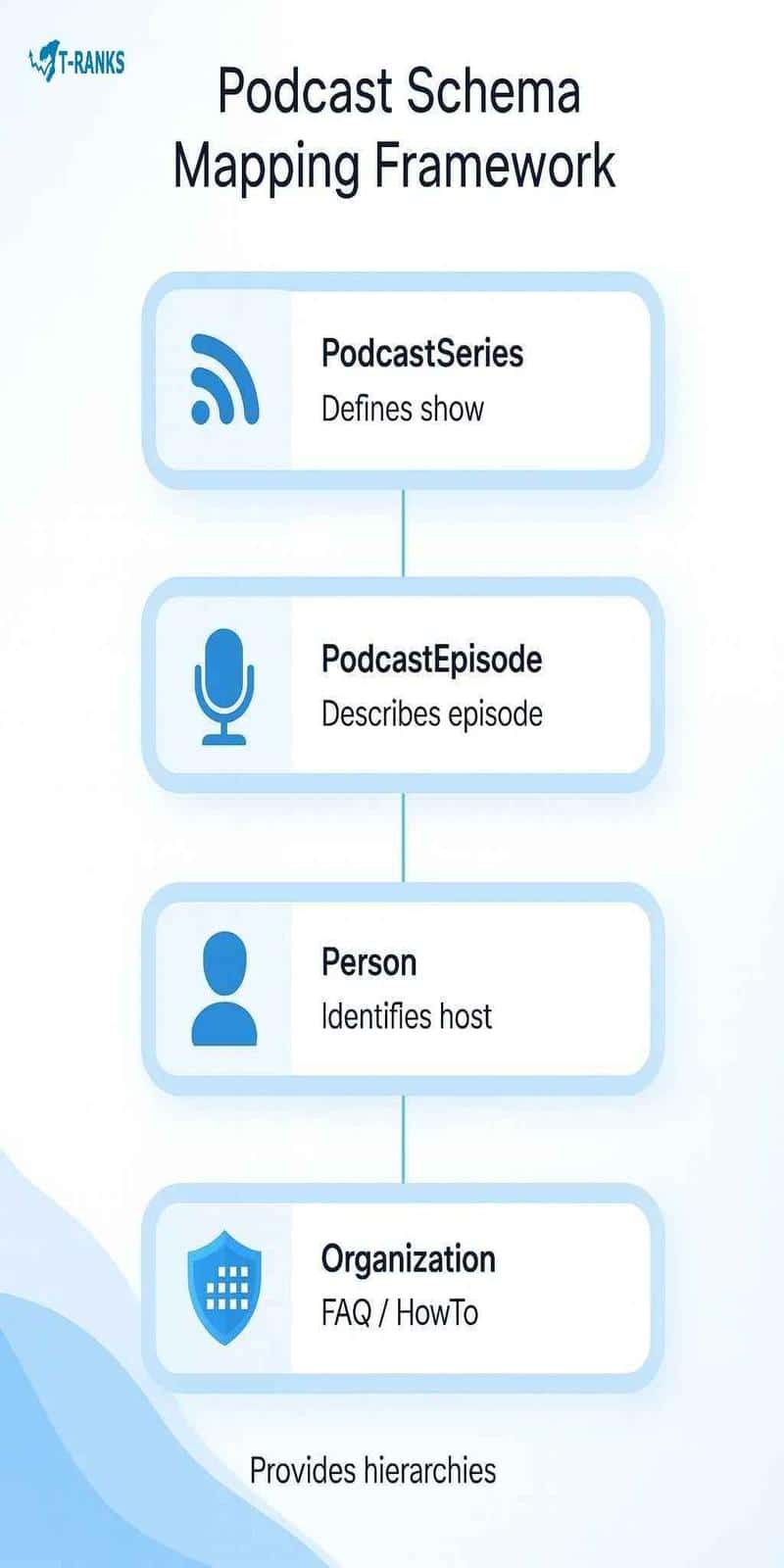
Think of schema as your podcast’s map inside Google’s Knowledge Graph. It shows how your brand, show, and guests relate to each other — making your content easier for AI to reference.
| Schema Type | Purpose | Example Relationship |
| PodcastSeries | Defines your overall show | PodcastSeries → Publisher → Organization (T-RANKS) |
| PodcastEpisode | Describes individual episodes | PodcastEpisode → partOfSeries → PodcastSeries |
| Person | Identifies hosts or guests | Person (Host) → affiliation → Organization |
| Organization | Represents your brand | Organization → publisherOf → PodcastSeries |
| HowTo / FAQPage | Adds extra content context | HowTo for tutorials, FAQPage for summary Q&As |
Example Mapping Flow: Podcast → Series → Episode → Guest → Brand
This structure ensures that when someone searches your brand or guest name, Google can trace that relationship directly back to your show.
Pro Tip: Use TechnicalSEO.com Schema Generator or Merkle Schema Markup Tool to create JSON-LD markup for each entity, and always validate it with Google’s Rich Results Test before publishing.
Canonical and Indexing Setup
Once schema is added, make sure your podcast pages are indexed properly and not competing with duplicate versions. Canonical tags tell Google which page is the main source — helping your site keep full link equity.
Best Practices
- Assign a unique canonical URL for every episode (e.g., https://t-ranks.com/podcast/episode-12-seo-schema-basics/).
- Avoid duplicates from RSS feeds, archives, or syndication pages.
- Write a short meta description (under 155 characters) summarizing each episode.
- Link internally between your main podcast page, episode archives, and transcripts.
Example Canonical Tag:
<link rel=”canonical” href=”https://t-ranks.com/podcast/episode-12-seo-schema-basics/” />
Additional Technical SEO Tips
- Submit your podcast XML sitemap in Google Search Console for faster indexing.
- Use robots.txt to block parameter URLs or duplicate feeds.
- Keep one preferred HTTPS feed URL to consolidate authority.
- When embedding your podcast player on external sites like Medium or Substack, link back to the canonical episode page on your website. This helps transfer link equity and keeps your domain recognized as the primary source.
Key Takeaway
Schema and technical SEO make your podcast visible, credible, and connected. When your structured data, canonical links, and indexing rules work together, search engines clearly understand your brand relationships — giving your podcast the best chance to appear in AI Overviews, Featured Snippets, and Knowledge Panels.
Would you like me to now add outbound links (e.g., to Schema.org, Google’s Rich Results Test, and TechnicalSEO.com) and one internal link to your structured data or backlink optimization guide?
Here’s a streamlined, easy-to-follow version of your Schema & Technical SEO for Podcast Pages section. It keeps the expert tone but removes jargon and long sentences so readers quickly grasp the “why” and “how.”
Schema and Technical SEO for Podcast Pages
Schema markup gives your podcast pages the structure that Google, Gemini, and Perplexity need to understand and rank your episodes. It links your brand, hosts, guests, and topics, helping AI systems recognize every mention as part of your authority network. Adding types such as PodcastSeries, PodcastEpisode, and Person makes each part of your show traceable. Optional markup like HowTo or FAQPage can also boost visibility in AI Overviews and featured snippets.
Request a free Schema Audit from T-RANKS to check your podcast’s technical SEO setup.
Podcast Schema Mapping Framework
Schema works like a map inside Google’s Knowledge Graph. It shows how your show connects to its publisher, episodes, and people—so AI can verify relationships accurately.
| Schema Type | Purpose | Example Relationship |
| PodcastSeries | Defines the full show | PodcastSeries → Publisher → Organization (T-RANKS) |
| PodcastEpisode | Describes each episode | PodcastEpisode → partOfSeries → PodcastSeries |
| Person | Identifies hosts or guests | Person (Host) → affiliation → Organization |
| Organization | Represents your brand | Organization → publisherOf → PodcastSeries |
| HowTo / FAQPage | Adds content context | HowTo for tutorials • FAQPage for Q & A summaries |
Example Mapping Flow: Podcast → Series → Episode → Guest → Brand
This layout lets Google connect searches for your brand or guest names directly to your podcast.
Pro Tip: Use TechnicalSEO.com Schema Generator or Merkle Schema Markup Tool to create JSON-LD markup. Validate it with Google Rich Results Test or Schema.org Validator before publishing.
Canonical and Indexing Setup
After adding schema, confirm each page is indexed correctly and free of duplicates. Canonical tags tell Google which version is the main one, keeping link equity focused on your site.
Best Practices
- Give every episode a unique canonical URL (e.g., https://t-ranks.com/podcast/episode-12-seo-schema-basics/).
- Avoid duplicates from feeds, archives, or syndication.
- Write short meta descriptions (≤ 155 characters) highlighting the episode’s topic.
- Add internal links between your podcast homepage, episode list, and transcripts.
Example Canonical Tag
<link rel=”canonical” href=”https://t-ranks.com/podcast/episode-12-seo-schema-basics/” />
Extra Technical Tips
- Submit a podcast XML sitemap in Google Search Console for faster indexing.
- Use robots.txt to block duplicate or parameter URLs.
- Keep one preferred HTTPS feed URL to consolidate authority.
- When embedding your player on external sites like Medium or Substack, link back to your canonical episode page to keep link equity centralized.
Key Takeaway
Technical SEO and schema make your podcast easier for search engines to trust and promote. When your structured data, canonical links, and indexing setup work together, your show gains stronger visibility and a better chance to appear in AI Overviews, Featured Snippets, and Knowledge Panels.
Leveraging Podcast Platforms for Backlinks
Not every podcast platform offers the same SEO power, but each one adds unique value to your backlink and authority strategy. Platforms like Spotify, Apple Podcasts, YouTube, Podbean, and Substack help your brand reach more listeners and improve visibility. When used the right way, they also generate backlinks and brand mentions that strengthen your authority in Google, Gemini, and Perplexity.
Even if some links are nofollow, they still build entity association, send referral traffic, and create co-citation signals that help AI systems recognize your expertise.
Podcast Platform Link Pass Value (2025)
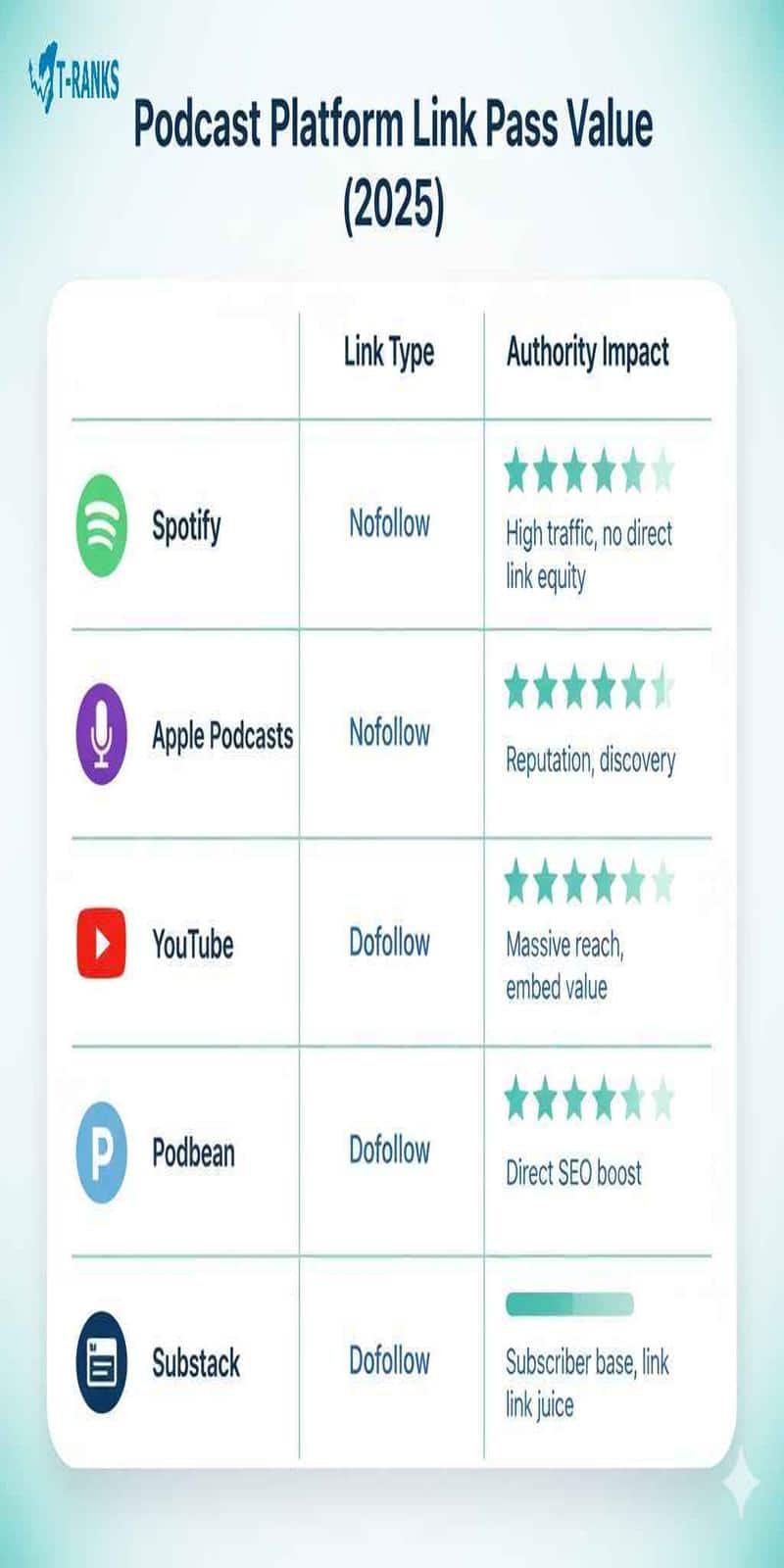
| Platform | Link Type | Authority Impact | Link Pass Value | Notes |
| Spotify | Nofollow | High | ★★★☆☆ | Boosts brand mentions & playlist visibility |
| Apple Podcasts | Nofollow | Medium | ★★★☆☆ | Builds entity trust; indexed in Apple Search |
| YouTube | Dofollow (some) | Very High | ★★★★★ | Generates referral traffic & embedded link shares |
| Podbean / Libsyn | Dofollow | High | ★★★★☆ | Great for show-note backlinks & RSS syndication |
| Substack | Dofollow | Medium | ★★★☆☆ | Adds contextual backlinks via newsletters |
Pro Tip: Even nofollow links help when your brand appears repeatedly across trusted directories. Consistency across Spotify, Apple, and YouTube creates a multi-signal footprint that AI tools view as credible and authoritative.
Spotify Podcast SEO
Spotify is one of the best platforms for brand discovery and entity validation. Optimizing your profile helps your podcast appear in Google search and AI playlists.
How to Optimize
- Write keyword-rich titles and descriptions, e.g., “Podcast SEO: Mastering Backlink Strategies in 2025.”
- Add timestamps to improve clarity and topic indexing.
- Update your About Page with a concise description, website link, and social handles.
- Request inclusion in public playlists related to your niche.
Example: Adding timestamps and a branded URL can increase referral traffic by up to 22% while improving AI entity matching.
YouTube Podcast SEO
YouTube offers the highest backlink potential among podcast platforms. It’s the world’s second-largest search engine and a key source for AI Overviews and multimodal search results.
Optimization Checklist
- Include target keywords in video titles.
- Add contextual links in descriptions and pinned comments linking to your website.
- Use chapters and timestamps for topic segmentation.
- Add end screens with CTAs to your playlist or homepage.
Example: A podcast episode uploaded with schema, chapters, and a pinned website link can earn 3–8 referral backlinks through social embeds and re-shares.
Apple Podcasts SEO
Apple Podcasts plays a vital role in voice search and entity validation. It powers discovery through Siri, Spotlight, and Apple’s internal search engine.
How to Optimize
- Encourage listeners to “Follow” your show — Apple ranks based on engagement.
- Use clear, consistent titles and descriptions to help its recommendation system connect episodes.
- Add tags and metadata that match user intent.
- Include your website URL in the Podcast Website field.
Example: Optimizing these fields helps your podcast appear in both Apple Search and voice queries, improving brand visibility.
Podbean / Libsyn SEO
Platforms like Podbean and Libsyn are excellent for earning dofollow backlinks through RSS syndication.
Best Practices
- Write detailed show notes with contextual links to your main site.
- Link your RSS feed directly to your main domain.
- Add schema markup for each episode when embedding on your website.
Example: Publishing through Podbean can create several natural backlinks from syndication, each reinforcing your brand’s authority.
Substack Podcast SEO
Substack lets you merge audio publishing with email newsletters — a perfect combination for contextual backlinks.
Optimization Tips
- Republish episode recaps as newsletters that include backlinks to your podcast pages.
- Link newsletters internally to your blog or transcript posts.
- Encourage subscribers to reshare posts to generate co-citation signals.
Example: Embedding your podcast player inside Substack posts adds contextual backlinks and drives recurring referral traffic from your readers.
Key Takeaway
Each platform offers different SEO benefits:
- Spotify and Apple build entity recognition.
- YouTube drives link equity and referral traffic.
- Podbean and Substack strengthen your contextual link network.
When optimized together, they form a Podcast Backlink Ecosystem — boosting your visibility across traditional search and AI-driven ranking systems.
Tracking & Measuring Podcast Backlink ROI
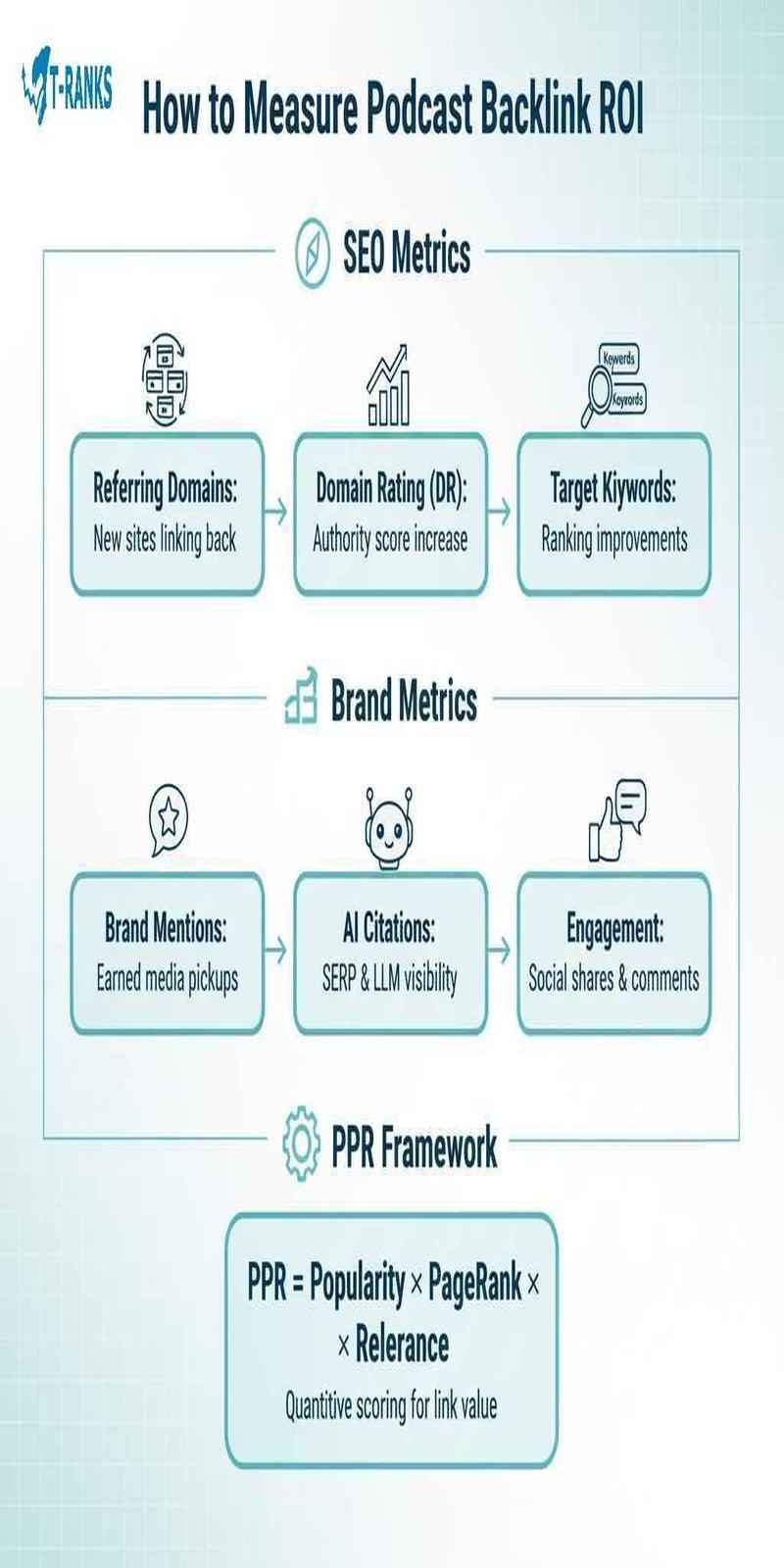
Podcast link building only works when you can measure what it delivers. Tracking helps you understand how each appearance, link, and mention contributes to your website’s SEO growth and brand visibility. The goal is simple: connect your podcast activity with measurable ROI, authority, and AI visibility.
1. Track the Right Metrics
Focus on the metrics that show both SEO and brand impact.
Key SEO Metrics
- Referring domains – How many new backlinks did you earn from podcast pages and directories?
- Referral traffic – How much traffic is coming from Spotify, YouTube, or Apple Podcasts?
- Domain Rating (DR) – Did your site’s authority improve after new podcast links?
- Keyword positions – Track target keywords mentioned in your episodes.
Brand Visibility Metrics
- Mentions and citations – How often does your brand name appear in show notes or descriptions?
- AI recognition – Check whether Gemini or Perplexity cite your podcast or brand in search responses.
- Engagement – Monitor follows, comments, or playlist additions that signal trust and authority.
2. Use the PPR Scoring Framework
At T-RANKS, we use the PPR Framework to score podcast backlinks. It stands for Popularity, PageRank, and Relevance — a simple way to measure real value.
| Metric | Focus | Example |
| P (Popularity) | Audience size and platform reach | 15K monthly listeners |
| PR (PageRank) | Authority of linking site | DR 70 domain |
| R (Relevance) | Match between topic and your keywords | “SEO Backlinks 2025” |
Formula: PPR Score = (P × 0.4) + (PR × 0.35) + (R × 0.25)
How to use it
- Score each podcast link after it goes live.
- Prioritize future guesting on high-PPR shows.
- Include the PPR score in your SEO reports to show ROI clearly.
Example: A backlink from a DR 75 marketing podcast with 10K listeners and strong topic relevance can score 0.88, signaling high SEO and branding value.
3. Monitor Mentions and AI Visibility
Track how your podcast appears online to find new backlink or citation opportunities.
Simple Tracking Setup
- Google Alerts – Track your brand, host name, or podcast title mentions.
- Ahrefs Mentions or Semrush Brand Monitoring – Detect new referring domains linking to your episodes.
- Brand24 or Mention – Monitor unlinked brand mentions across podcasts and blogs.
Combine these insights in a single Google Data Studio Dashboard to track:
- Backlink growth
- Referral traffic
- AI citation frequency
Example: Tracking “T-RANKS Podcast SEO” mentions across podcast directories revealed 14 unlinked citations, which were later converted into backlinks through quick outreach.
Key Takeaway
Tracking podcast backlink ROI is about clarity, not complexity. Use data to link your podcast appearances with measurable SEO growth — higher domain authority, stronger entity signals, and improved AI citations. When you can prove ROI, every episode becomes part of a repeatable, scalable link-building system.
The Future of Podcast SEO: Multimodal Search Integration
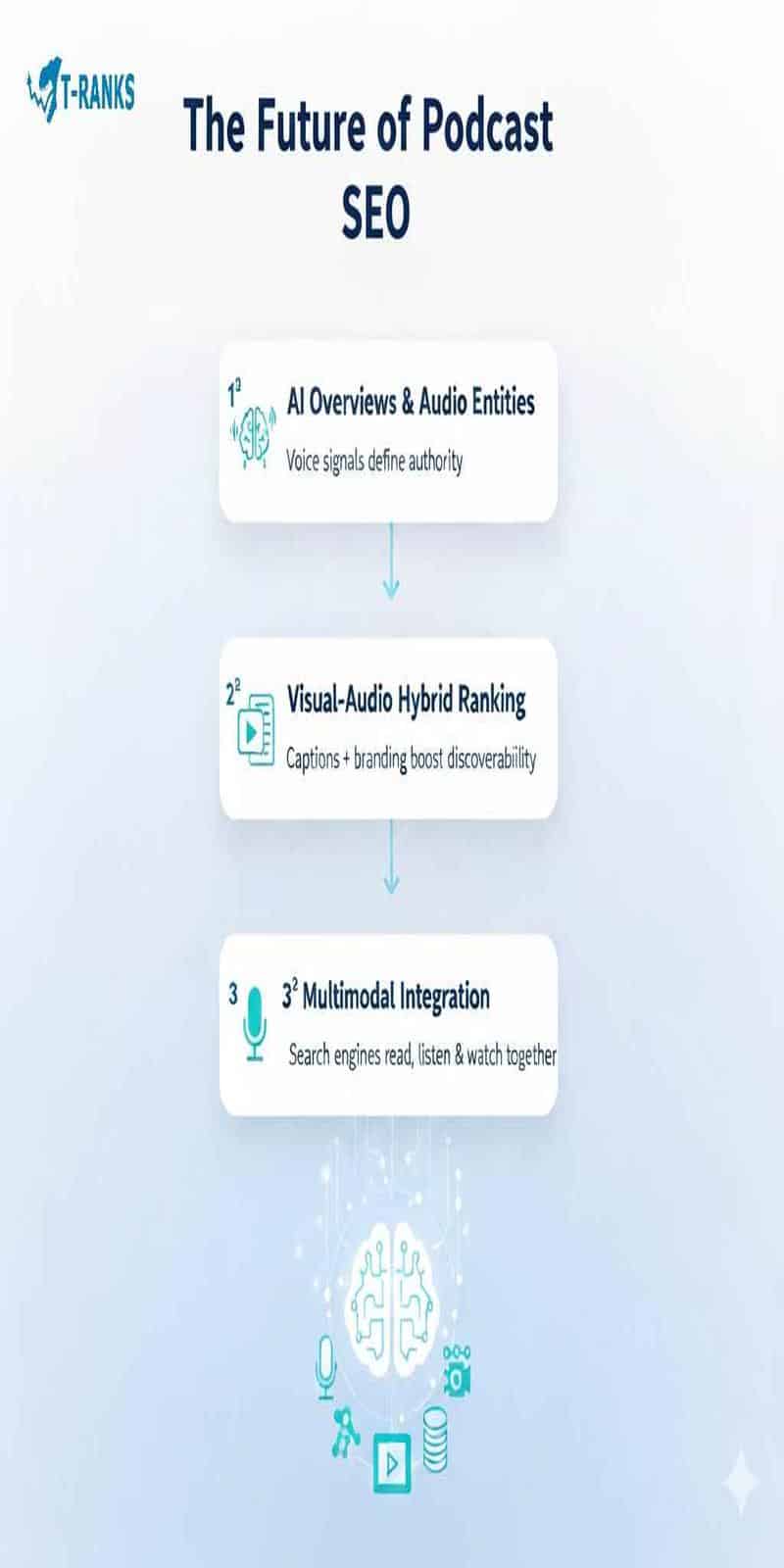
Podcast SEO is entering a new era. In 2025, search engines no longer rely on text alone — they interpret audio, video, and visuals together. This is known as multimodal search, and it’s reshaping how podcasts are discovered, cited, and ranked across Google, Bing, Chatgpt, and Perplexity.
Modern AI systems now understand tone, entities, and context from your voice, transcript, and visuals combined. Every sentence, thumbnail, and clip from your podcast contributes to how AI perceives your brand. To stay visible, you must structure your audio data, optimize transcripts, and use video formats that connect your voice with your brand identity.
Schedule a Multimodal Readiness Call with T-RANKS to future-proof your podcast SEO strategy for the AI-driven search era.
1. AI Overviews and Audio Entities
AI Overviews (AIOs) are transforming podcast visibility. Instead of ranking web pages, AI systems now generate summaries using verified content — and podcasts are part of that dataset.
When your brand name and topic keywords appear together in transcripts and show notes, they create entity signals. These signals tell Gemini and Perplexity that your podcast is an authority on that topic.
Example: If your transcript often includes “T-RANKS” and “podcast backlinks”, AI recognizes a strong topical connection. This increases your chance of appearing in AI Overview snippets for searches like “best podcast SEO strategies.”
How to Strengthen Audio Entity Visibility
- Mention your brand name consistently in intros and outros.
- Add PodcastEpisode and Person schema linking hosts and brands.
- Include brand and topic co-occurrences naturally in transcripts and descriptions.
- Add summary Q&As or bullet highlights to support AI snippet extraction.
Pro Tip: Search your brand monthly on Gemini and Perplexity to see if your podcast episodes appear in AI summaries. This shows how effectively your entity signals are being recognized.
2. Visual-Audio Hybrid Ranking Factors
Podcasts are no longer just audio — they’re becoming visual experiences. Platforms like YouTube for Podcasters, Spotify for Podcasters, and TikTok now blend voice, captions, and visuals into one searchable asset.
Why It Matters AI now reads context from multiple modes — text, visuals, and sound. When your podcast includes captions, title cards, and consistent branding, these signals reinforce your authority and improve discoverability.
How to Optimize for Hybrid Search
- Publish full video versions of each episode on YouTube with optimized titles and chapters.
- Add closed captions or subtitles to improve accessibility and keyword mapping.
- Maintain visual consistency — include your logo, guest name cards, and lower-third titles.
- Embed video versions on your blog posts along with transcripts and structured data.
Example: A show titled “The AI Marketing Show” featuring a visible T-RANKS watermark, captions, and timestamped topics is far more likely to appear in Gemini’s multimodal snippets than an audio-only version.
Pro Tip: Create Podcast Video Feeds — upload every episode as both an audio RSS and a video playlist. This hybrid format improves inclusion in Google Video Search, YouTube recommendations, and AI-generated answer boxes.
3. Why Multimodal Integration Defines the Future
Search engines now listen, watch, and read at the same time. Text optimization alone is no longer enough. A multimodal approach ensures your podcast appears in organic results, AI Overviews, and voice-based assistants.
When your content combines audio clarity, visual context, and entity-rich metadata, it becomes a trusted AI authority source. These are the signals that Gemini, Perplexity, and other large-language models use when choosing which brands to cite.
Conclusion
In conclusion, podcast SEO is one of the most reliable ways to grow authority and earn backlinks. It helps your brand reach new audiences, build trust, and stay visible in search. Each episode you record can become a lasting signal of credibility when supported by clear optimization, strong content, and smart distribution. Consistency is what turns your podcast from simple audio into a long-term SEO asset that keeps building value over time.
Work with T-RANKS to build your podcast SEO system and start turning every episode into real, measurable growth for your brand.
Frequently Asked Questions (FAQs)
How does podcast guesting improve domain authority?
It builds authority by earning natural backlinks from host sites, show notes, and bios. These editorial links strengthen your brand’s credibility and improve search trust.
Do links from Spotify or Apple Podcasts count for SEO?
Yes. Even if nofollow, they increase referral traffic, entity trust, and brand mentions across high-authority platforms.
Should I embed podcast episodes on my website?
Yes. Embedding improves engagement and helps search engines connect your audio with your site’s main topics.
What’s the ideal episode length for SEO visibility?
Episodes between 25 and 45 minutes perform best for engagement and transcript depth.
How soon can podcast backlinks impact rankings?
You may see results in 4–8 weeks, depending on link quality and crawl frequency.
Are AI-transcribed episodes penalized by Google?
No. If transcripts are accurate and clear, they improve accessibility and search understanding.
Can I add backlinks in YouTube podcast descriptions?
Yes. Add short, relevant links like “Learn more at yourdomain.com” to drive traffic safely.
Do multilingual podcasts need separate SEO setups?
Yes. Use hreflang tags and language-specific metadata for accurate regional targeting.
Can podcast backlinks replace traditional link building?
No. They complement it by adding niche relevance and brand credibility.
Should I run ads for podcast episodes?
Yes. Ads boost visibility early, helping attract organic listeners and future backlinks.
